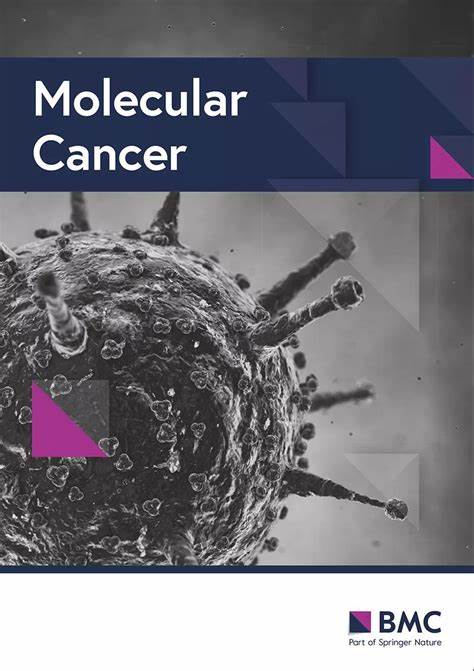o8G-modified circPLCE1 inhibits lung cancer progression via chaperone-mediated autophagy
IF 27.7
1区 医学
Q1 BIOCHEMISTRY & MOLECULAR BIOLOGY
引用次数: 0
Abstract
Lung cancer poses a serious threat to human health, but its molecular mechanisms remain unclear. Circular RNAs (circRNAs) are closely associated with tumour progression, and the important role of 8-oxoguanine (o8G) modification in regulating the fate of RNA has been gradually revealed. However, o8G modification of circRNAs has not been reported. We identified circPLCE1, which is significantly downregulated in lung cancer, and further investigated the o8G modification of circPLCE1 and the related mechanism in lung cancer progression. We identified differentially expressed circRNAs by RNA high-throughput sequencing and then conducted methylated RNA immunoprecipitation (MeRIP), immunofluorescence (IF) analysis, crosslinking immunoprecipitation (CLIP) and actinomycin D (ActD) assays to explore circPLCE1 o8G modification. The biological functions of circPLCE1 in vivo and in vitro were clarified via establishing a circPLCE1 silencing/overexpression system. Tagged RNA affinity purification (TRAP), RNA Immunoprecipitation (RIP) and coimmunoprecipitation (Co-IP) assays, and pSIN-PAmCherry-KFERQ-NE reporter gene were used to elucidate the molecular mechanism by which circPLCE1 inhibits lung cancer progression. This study revealed that reactive oxygen species (ROS) can induce circPLCE1 o8G modification and that AUF1 can mediate a decrease in circPLCE1 stability. We found that circPLCE1 significantly inhibited lung cancer progression in vitro and in vivo and that its expression was associated with tumour stage and prognosis. The molecular mechanism was elucidated: circPLCE1 targets the HSC70 protein, increases its ubiquitination level, regulates ATG5-dependent macroautophagy via the chaperone-mediated autophagy (CMA) pathway, and ultimately inhibits lung cancer progression. o8G-modified circPLCE1 inhibits lung cancer progression through CMA to inhibit macroautophagy and alter cell fate. This study provides not only a new theoretical basis for elucidating the molecular mechanism of lung cancer progression but also potential targets for lung cancer treatment. ROS induce circPLCE1 o8G modification, and AUF1 specifically recognizes o8G modification, thereby decreases circPLCE1 stability. circPLCE1 targets the HSC70 protein, increases its ubiquitination level, inhibits CMA activity, and promotes ATG5-dependent macroautophagy via the CMA pathway, altering the fate of tumour cells and ultimately inhibiting lung cancer progression.o8g修饰的circPLCE1通过伴侣介导的自噬抑制肺癌进展
肺癌对人类健康构成严重威胁,但其分子机制尚不清楚。环状RNA (circRNAs)与肿瘤进展密切相关,8-氧鸟嘌呤(o8G)修饰在调控RNA命运中的重要作用已逐渐被揭示。然而,circrna的o8G修饰尚未见报道。我们确定了在肺癌中显著下调的circPLCE1,并进一步研究了circPLCE1的o8G修饰及其在肺癌进展中的相关机制。我们通过RNA高通量测序鉴定出差异表达的circRNAs,然后进行甲基化RNA免疫沉淀(MeRIP)、免疫荧光(IF)分析、交联免疫沉淀(CLIP)和放线菌素D (ActD)检测来探索circPLCE1 o8G修饰。通过建立circPLCE1沉默/过表达系统,阐明了circPLCE1在体内和体外的生物学功能。通过标记RNA亲和纯化(TRAP)、RNA免疫沉淀(RIP)和共免疫沉淀(Co-IP)实验,以及pSIN-PAmCherry-KFERQ-NE报告基因,阐明circPLCE1抑制肺癌进展的分子机制。本研究发现活性氧(reactive oxygen species, ROS)可诱导circPLCE1 o8G修饰,AUF1可介导circPLCE1稳定性的降低。我们发现circPLCE1在体外和体内均能显著抑制肺癌的进展,其表达与肿瘤分期和预后相关。阐明了其分子机制:circPLCE1靶向HSC70蛋白,提高其泛素化水平,通过伴侣介导的自噬(CMA)途径调控atg5依赖性巨噬,最终抑制肺癌进展。o8g修饰的circPLCE1通过CMA抑制巨噬,改变细胞命运,抑制肺癌进展。该研究不仅为阐明肺癌进展的分子机制提供了新的理论依据,也为肺癌治疗提供了潜在靶点。ROS诱导circPLCE1的o8G修饰,而AUF1特异性识别o8G修饰,从而降低了circPLCE1的稳定性。circPLCE1靶向HSC70蛋白,提高其泛素化水平,抑制CMA活性,并通过CMA途径促进atg5依赖性巨噬,改变肿瘤细胞的命运,最终抑制肺癌的进展。
本文章由计算机程序翻译,如有差异,请以英文原文为准。
求助全文
约1分钟内获得全文
求助全文
来源期刊

Molecular Cancer
医学-生化与分子生物学
CiteScore
54.90
自引率
2.70%
发文量
224
审稿时长
2 months
期刊介绍:
Molecular Cancer is a platform that encourages the exchange of ideas and discoveries in the field of cancer research, particularly focusing on the molecular aspects. Our goal is to facilitate discussions and provide insights into various areas of cancer and related biomedical science. We welcome articles from basic, translational, and clinical research that contribute to the advancement of understanding, prevention, diagnosis, and treatment of cancer.
The scope of topics covered in Molecular Cancer is diverse and inclusive. These include, but are not limited to, cell and tumor biology, angiogenesis, utilizing animal models, understanding metastasis, exploring cancer antigens and the immune response, investigating cellular signaling and molecular biology, examining epidemiology, genetic and molecular profiling of cancer, identifying molecular targets, studying cancer stem cells, exploring DNA damage and repair mechanisms, analyzing cell cycle regulation, investigating apoptosis, exploring molecular virology, and evaluating vaccine and antibody-based cancer therapies.
Molecular Cancer serves as an important platform for sharing exciting discoveries in cancer-related research. It offers an unparalleled opportunity to communicate information to both specialists and the general public. The online presence of Molecular Cancer enables immediate publication of accepted articles and facilitates the presentation of large datasets and supplementary information. This ensures that new research is efficiently and rapidly disseminated to the scientific community.
 求助内容:
求助内容: 应助结果提醒方式:
应助结果提醒方式:


